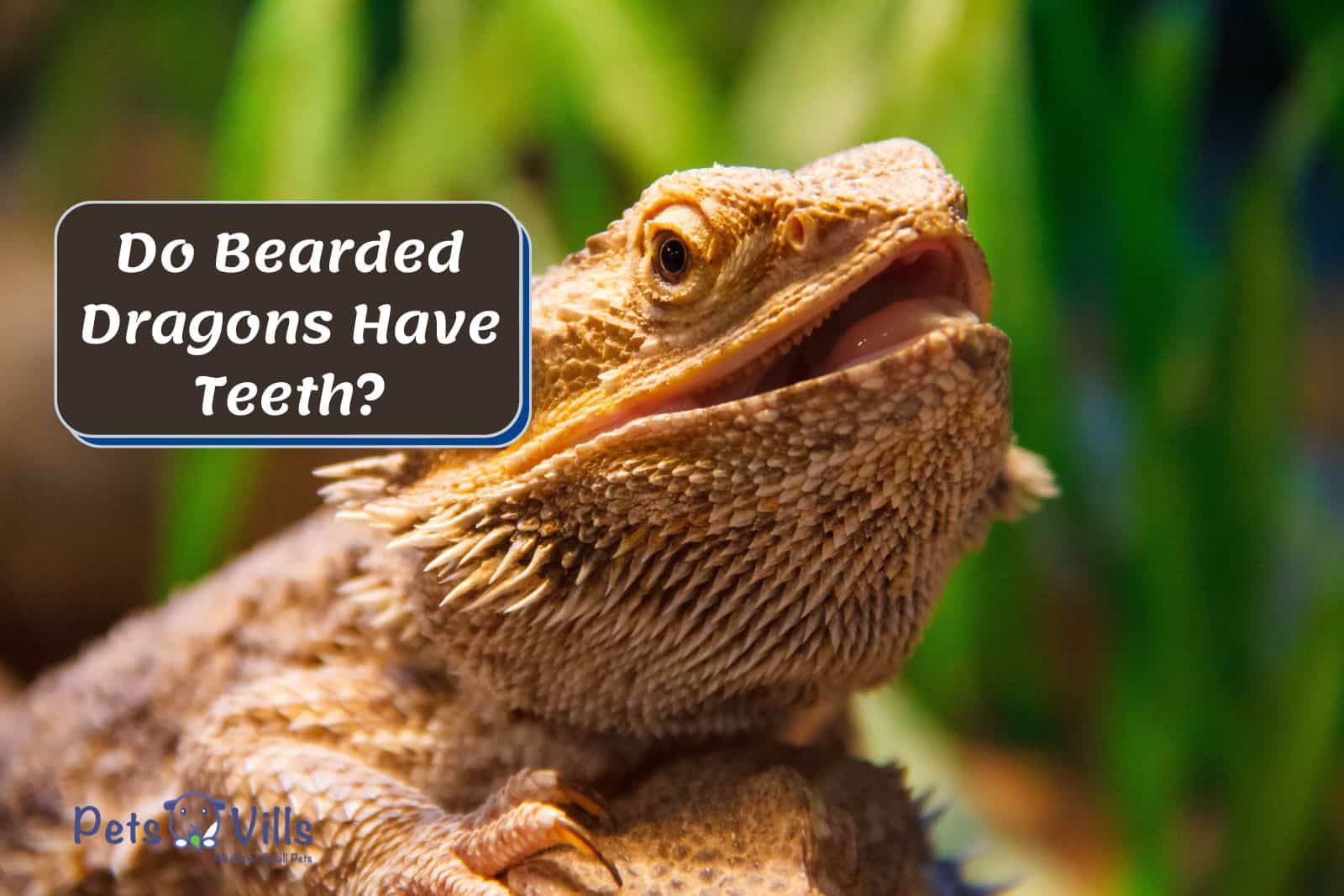Do bearded dragons have teeth? It’s a much more detailed topic than one might assume.1
I was certainly surprised by this topic’s depth when first researching it.
So I decided to make it easy for everyone by creating a comprehensive guide.
Just read on, and you will soon answer all your questions about bearded dragon teeth.
Also Read: Why is Bearded Dragon Holding Mouth Open?
Table of Contents
Do Bearded Dragons Have Teeth?
The simple answer is yes; our bearded dragon friends do have teeth. In fact, they’re born with a set of sharp teeth rather than needing to wait for them to grow like humans.
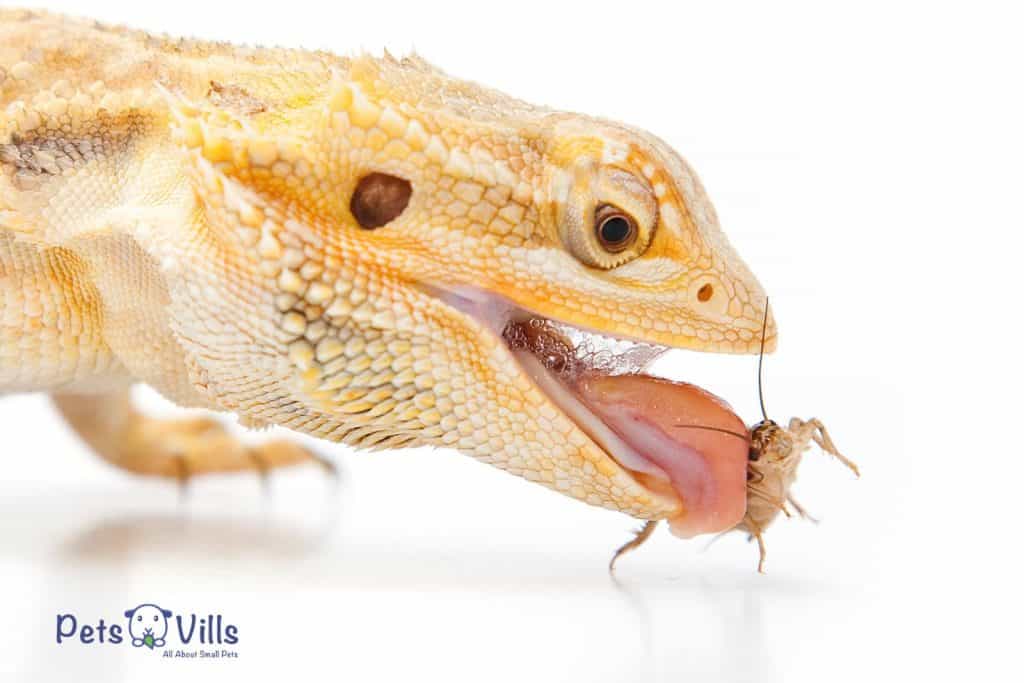
These sharp teeth play a fundamental role in getting baby dragons on the right track. It allows them to chew and eat their favorite insects from the jump.
But you’re probably now wondering why you people don’t notice these teeth.
The confusion comes from their teeth being small and barely visible. It often leads people to assume these dragons don’t have teeth because they can’t see them.
Interestingly, the teeth size doesn’t change much during the tooth developmental stages. You’ll still be squinting to see them even when your beardie’s mouth is open at any age.
What Are Bearded Dragon Teeth?
Bearded dragon teeth serve an essential purpose for our lizard friends. They ensure our beardies can obtain and digest their food quickly.
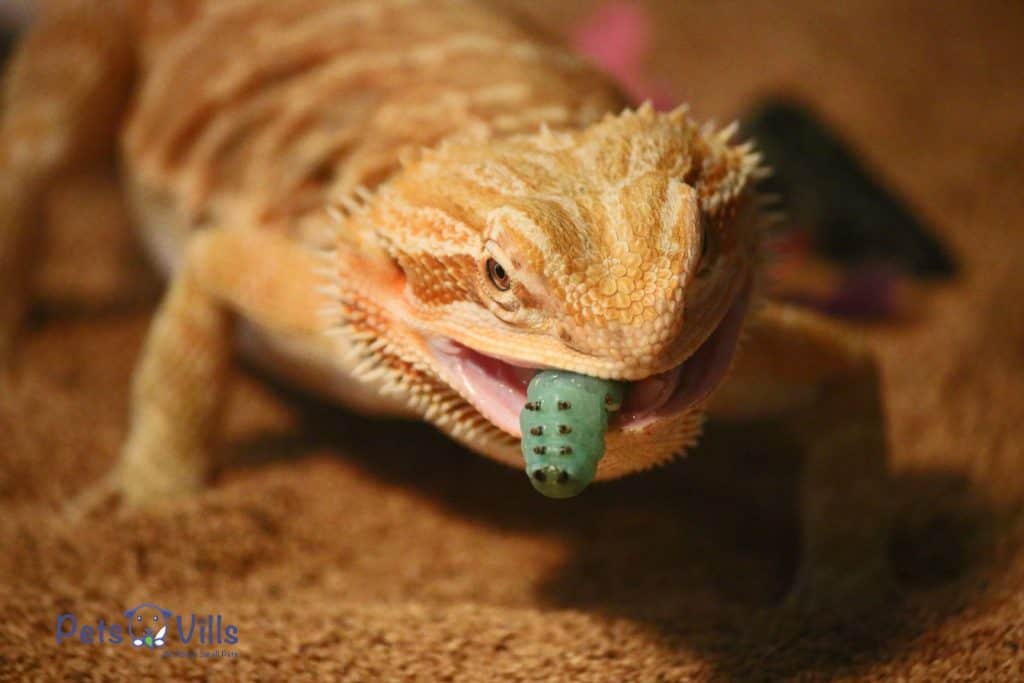
In this way, their teeth aren’t much different than ours. We both use them to chew and break down food to prevent choking or other hazards.
They may do it more safely and efficiently than I do, as I’m known for scarfing down my food. But it still doesn’t change that the primary purpose of our sets of teeth is the same.
However, this shared purpose is where the similarities stop. The following two sections will provide more context into the differences between our teeth.
Number of Teeth
Bearded dragons are known for having up to 80 teeth. It’s an impressive number compared to the measly 32 teeth of most adult humans (1).
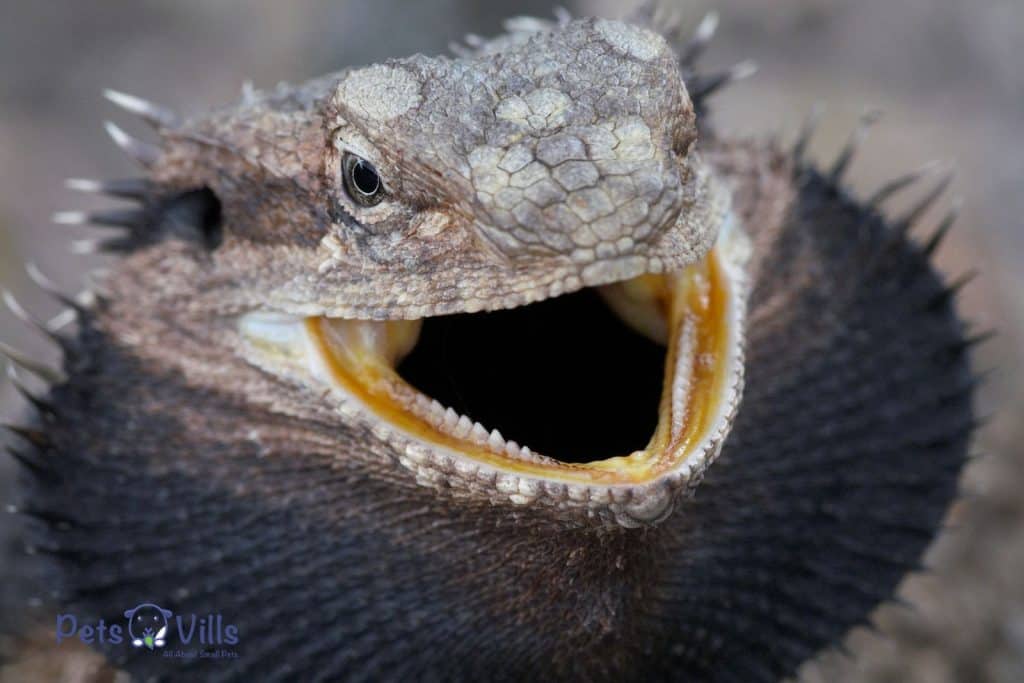
It’s a bit hard to believe they have enough room to fit them all. But the teeth are distributed relatively evenly between a beardie’s lower and upper jaws.
For instance, their lower jaws average between 26 to 40 teeth (13 to 20 per side). The upper jaw is less crowded, with an average of 22 to 34 teeth (11 to 17 per side).
It’s a distribution that seems to work wonderfully. After all, I’ve never seen a bearded dragon lizard have trouble eating its food.
Types of Teeth
Beardie teeth aren’t all considered the same type. Instead, they’re divided into two variations: pleurodont teeth and acrodont teeth (2).
Pleurodont teeth are the rarer of these two types. So you’ll only find a few at the front of your’ bearded dragon’s mouth.
I wouldn’t advise overlooking them, though, as they’re vital for eating. These teeth have long, sharp structures perfect for biting down on food.
I should also mention that bearded dragon pleurodont teeth have deep roots fused to your dragon’s jawbone. It’ll help ensure these teeth have almost no possibility of falling out.
But this stability doesn’t mean pleurodont teeth won’t need proper care. In our next section, you’ll learn much more about how to care for them properly.
The second type, acrodont teeth, are notable for their placement near the back of the mouth. It makes them an essential component of chewing foods.
Given this information, it won’t be shocking to learn that acrodont teeth are short and triangle-shaped. I can easily imagine how they would be much more suitable for chewing than pleurodont teeth.
Another compelling thing about them is they can fall out when neglected. So bearded dragon owners must stay vigilant about keeping them in good condition.
5 Methods to Prevent Bearded Dragon Teeth Issues
Providing your bearded dragon with high-quality dental care is a necessity. Here are five preventative actions that’ll help you to do it and ensure their teeth stay pristine:
#1 Cleaning Their Teeth Properly
Learning how to clean your dragon’s teeth properly is pivotal. It’s the most critical way to prevent their dental health from plummeting.
My recommended method would be wetting a cotton bud or ball. You then use it to wipe around your little friend’s tooth row and gums.
But make sure to remain calm and avoid working too fast. Otherwise, your dragon might become displeased and attempt to bite you as mine did.
I’d suggest doing this cleaning twice weekly for the best results. It certainly has helped my bearded dragon get used to the process and improve his dental health.
Check out this video on how to take care of bearded dragon teeth.
@emma_queen_of_dragons Keep your dragon healthy! #beardeddragon #teeth #clean #lizard #fyp #jaws #cleanyourteeth #zero #red #yellow ♬ Clean Your Teeth – The Wiggles
#2 Rework Their Diet to Lessen Sugary Fruits
An improper diet can cause a severe potential impact on your beardie’s dental health. In most cases, teeth issues caused by diets stem from consuming too many sugary fruits.
It’s not too much different from how candy can rot a human’s teeth. Sugary fruits and citrus do the same for bearded dragons.
Once you’ve removed these fruits, replace them with vegetables and crunchy insects. These components are much more beneficial for a dragon’s teeth.
#3 Check Their Teeth Regularly
One of the easiest ways to ensure your dragon has functional teeth is by checking them. I’d recommend looking at their teeth at least every week or two to see what’s new.
During the exam, look for any notable signs of issues like build-ups. You can then address them quickly with a cleaning.
It’ll also allow you to address more severe issues quicker and get to the vet. For example, let’s say your beardie has black teeth or gums; you’ll know much sooner with these routine checks (3).
#4 Reduce Your Bearded Dragon’s Stress
A stressful environment can be pretty damaging to your beardie’s psyche. Sometimes, it can even lead to them banging their head against the container or fighting.
Both these situations can lead to dental issues, such as tooth loss. Therefore, it’s best to nip them in the bud before they get too far out of hand.
If you notice these behaviors, try to reduce their stress levels as soon as possible. It could be as simple as separating your dragons or repositioning their habitat.
I also wouldn’t suggest letting your dragons see themselves in a mirror. It might sound a bit weird, but this situation can stress them out immensely.
After all, look at what happens in this video.
It’s easy to see how they could damage their teeth in these situations. You’d be better off removing the mirror and moving it somewhere else.
#5 Keeping Your Dragon Off High Elevated Surfaces
Beardies have been known to fall off elevated surfaces once in a while. These situations can lead to them hitting their face and causing gum disease/tooth damage.
Neither of these outcomes is what any beardie owner wants to experience. Therefore, everyone will be much better off keeping these pets on ground surfaces as much as possible.
4 Notable Causes of Tooth Damage
Preventative measures only go so far if you don’t know what you’re fighting. But here are four of the more notable tooth damage causes to offer some much-needed context:
#1 Gingivitis
Gingivitis, or gingival recession, is a permanent condition that causes a dragon’s teeth to become overexposed. It does this through gum recession and making the teeth more vulnerable.
Sadly, gingivitis has been increasingly common among beardies. But owners who stick with proper teeth cleaning methods and provide good diets should avoid it.
#2 Periodontal Disease
Owners of beardies and some other lizard captive breedings are very familiar with this condition. In fact, “bearded dragons are predisposed to periodontal disease” (4).
If your dragon does contract periodontal disease, it won’t be pleasant. It’s a severe gum infection capable of hardening teeth and destroying jawbones if untreated.
Some more severe cases can even require surgical procedures. In other words, do whatever possible to avoid this condition.
Learn more about bearded dragon teeth disease from this cool video.
@lizzythespecialdragon Today’s Fun Fact Friday is all about Dental Disease in Bearded Dragon’s! 🦷🦎 #lizzythespecialdragon #dentaldisease #awareness #periodontaldisease #gingivitis #didyouknow #funfactfriday #funfact #learning #sharing #education #letslearn #beardeddragons #reptiles #tiktok #fyp #foryou #foryoupage ♬ Lucky’s Song (Happy Royalty Free Music) – ContiMusic
#3 Mouth Rot
Beardie mouth rot, or infectious stomatitis, is a serious bacterial infection in the gums (5). If left untreated, it can lead to several problematic symptoms:
- Bleeding gums
- Lack of appetite
- Missing teeth
- Excessive thick mucus
Any pet owner who notices white pus pockets in their beardie’s mouth should contact a vet. It’s a telltale sign for a lizard suffering from mouth rot.
#4 Tooth Trauma
Tooth trauma is a more unlikely candidate for causing dental damage. But it’s also the easiest to avoid because there isn’t an underlying condition or disease.
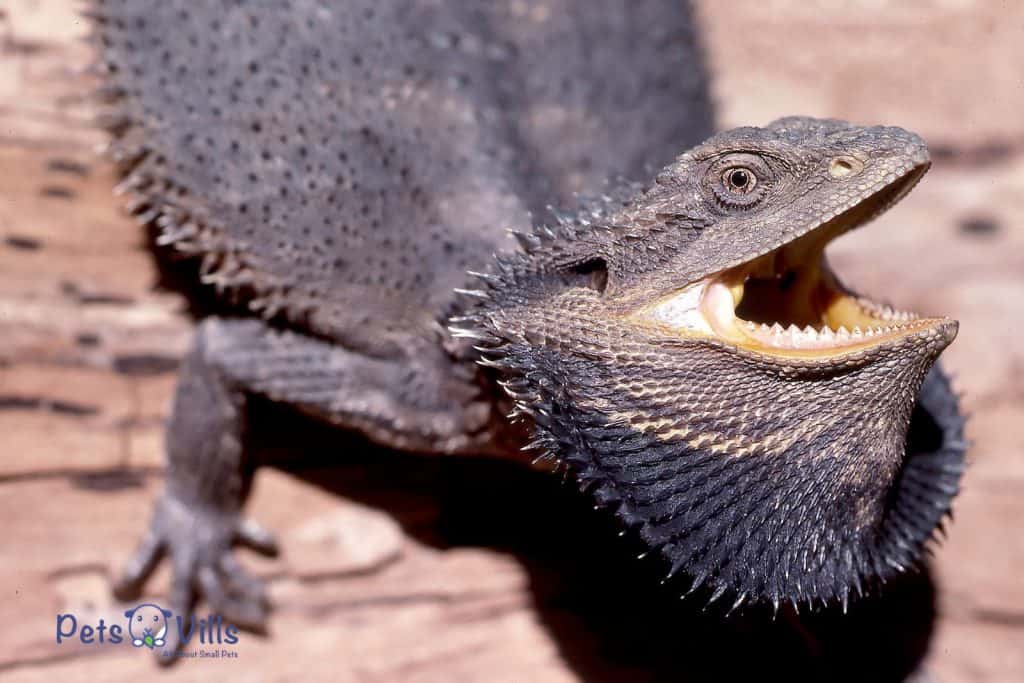
Instead, tooth trauma is caused by external sources. For example, it could be their owner accidentally hitting them in the teeth or smacking their face when falling from an elevated surface.
Can They Lose Teeth?
All of the causes mentioned above can lead to tooth loss and form tooth sockets. So it’s more than possible that your bearded dragon lizard will lose a tooth or two.
It also doesn’t help that their acrodont teeth aren’t the most sturdy. This issue is why many people consider beardies as prone to losing teeth.
Here are some reasons why beardie dragons hang their mouth open.
What To Do If Your Bearded Dragon Loses Their Teeth?
Anyone who notices their dragon’s missing a tooth should contact their vet. These professionals will walk you through the following steps and help diagnose the cause.
Trust me; these examinations will make you feel a lot better. It’s always better to spend a little money on a vet visit rather than let a problem linger.
FAQs
Do bearded dragons have sharp teeth?
Bearded dragons do have sharp teeth when they’re babies. But this sharpness will fade due to constant use when the beardie gets older.
Do bearded dragons teeth fall out?
A bearded dragon’s teeth don’t fall out naturally. But their acrodont dentition does fall out relatively easily when put under a force.
Conclusion
Do bearded dragons have teeth? Yes, they’re born with them. But their teeth often get worn down with time and develop issues without proper care.
So owners must stick with a proper cleaning schedule, a sufficient diet, and cultivate a stress-free habitat. It’ll help keep the teeth in good condition and prevent issues like periodontal disease.
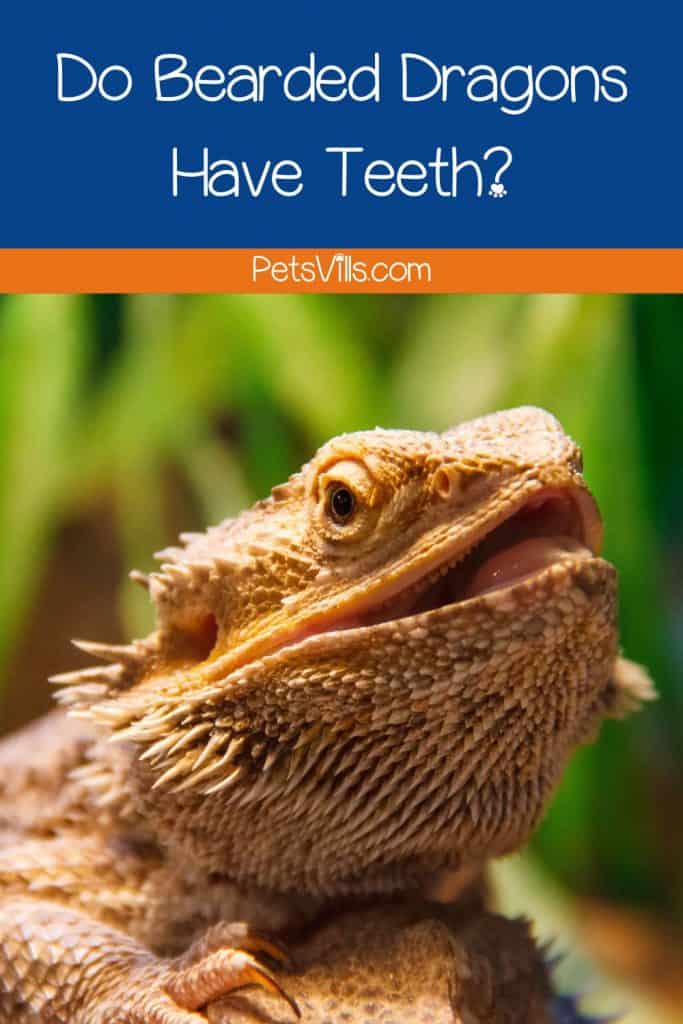
Resources
- 1. How Many Teeth Do We Have? | Colgate®. www.colgate.com. Accessed September 21, 2022. https://www.colgate.com/en-us/oral-health/mouth-and-teeth-anatomy/how-many-teeth-do-we-have#:~:text=Most%20adults%20have%2032%20teeth
- 2. Salomies L, Eymann J, Khan I, Di-Poï N. The alternative regenerative strategy of bearded dragon unveils the key processes underlying vertebrate tooth renewal. eLife. 2019;8. doi:10.7554/elife.47702
- 3. Wright K. Two Common Disorders of Captive Bearded Dragons (Pogona vitticeps): Nutritional Secondary Hyperparathyroidism and Constipation. Journal of Exotic Pet Medicine. 2008;17(4):267-272. doi:10.1053/j.jepm.2008.07.004
- 4. Warren R. Bearded Dragon’s Oral Diseases Treated. School of Veterinary Medicine. Published March 17, 2020. Accessed September 21, 2022. https://www.vetmed.ucdavis.edu/news/bearded-dragons-oral-diseases-treated#:~:text=Lizards%20like%20bearded%20dragons%20are
- 5. bearded-dragons-diseases | VCA Animal Hospital. Vca. Accessed September 21, 2022. https://vcahospitals.com/know-your-pet/bearded-dragons-diseases#:~:text=Infectious%20stomatitis%20(mouth%20rot)%20is
Grigorina grew up surrounded by animals – dogs, cats, cows, goats, sheep, and horses and that has shaped her into what I am today – a crazy cat lady who always has a place for one more cat (or a dog). She has two female cats – Kitty and Roni, and two tomcats – Blacky and Shaggy, but she also feeds her neighbors’ cats when they come for a visit. I just can’t say no to them. Follow her on FACEBOOK AND INSTAGRAM
Read her latest articles HERE
Learn more about her

